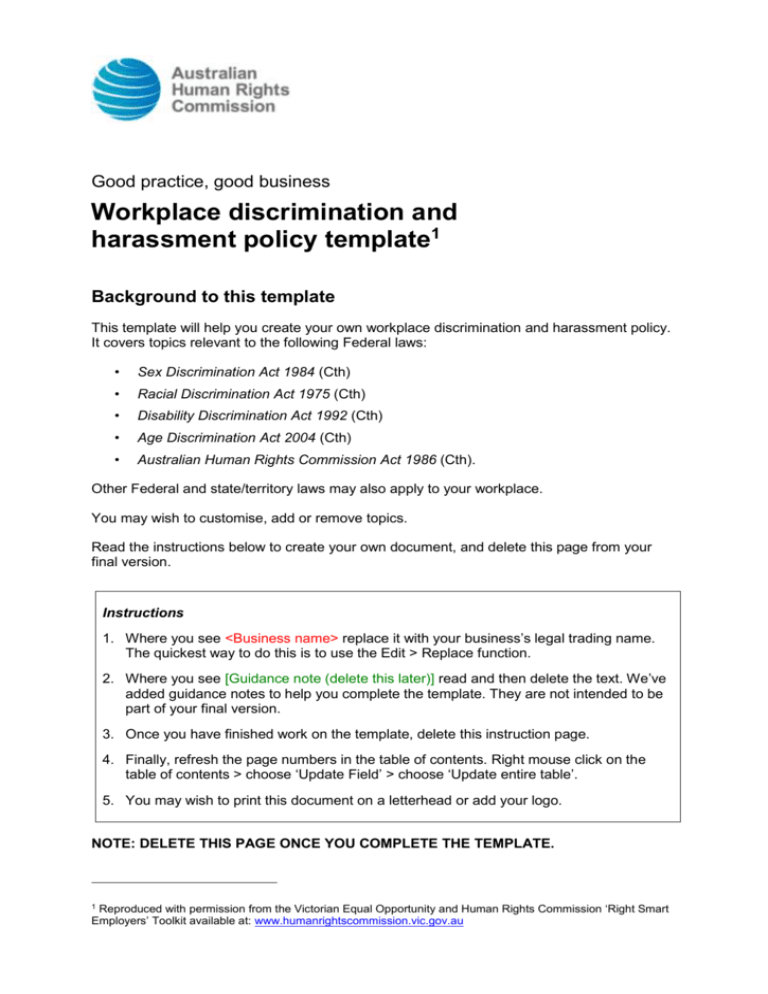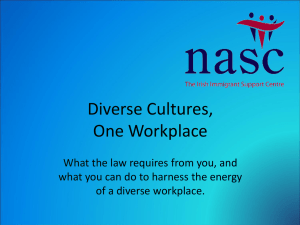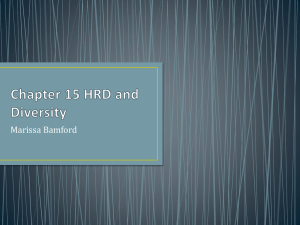Workplace discrimination and harassment policy template
advertisement

Good practice, good business Workplace discrimination and harassment policy template1 Background to this template This template will help you create your own workplace discrimination and harassment policy. It covers topics relevant to the following Federal laws: • Sex Discrimination Act 1984 (Cth) • Racial Discrimination Act 1975 (Cth) • Disability Discrimination Act 1992 (Cth) • Age Discrimination Act 2004 (Cth) • Australian Human Rights Commission Act 1986 (Cth). Other Federal and state/territory laws may also apply to your workplace. You may wish to customise, add or remove topics. Read the instructions below to create your own document, and delete this page from your final version. Instructions 1. Where you see <Business name> replace it with your business’s legal trading name. The quickest way to do this is to use the Edit > Replace function. 2. Where you see [Guidance note (delete this later)] read and then delete the text. We’ve added guidance notes to help you complete the template. They are not intended to be part of your final version. 3. Once you have finished work on the template, delete this instruction page. 4. Finally, refresh the page numbers in the table of contents. Right mouse click on the table of contents > choose ‘Update Field’ > choose ‘Update entire table’. 5. You may wish to print this document on a letterhead or add your logo. NOTE: DELETE THIS PAGE ONCE YOU COMPLETE THE TEMPLATE. Reproduced with permission from the Victorian Equal Opportunity and Human Rights Commission ‘Right Smart Employers’ Toolkit available at: www.humanrightscommission.vic.gov.au 1 <Business name> Workplace discrimination and harassment policy Background to this template 1. Scope 2. Aims 3. Staff rights and responsibilities 3.1 Additional responsibilities of managers and supervisors 4. Unacceptable workplace conduct 4.1 Discrimination 4.2 Bullying 4.3 Sexual harassment 4.4 Victimisation 4.5 Gossip 5. Merit at <Business name> 6. Resolving issues at <Business name> 6.1 Employee assistance program 7. Other relevant <Business name> policies 8. More information 9. Review details 1 2 2 3 3 4 4 5 5 6 6 7 7 7 7 8 8 1. Scope This policy applies to: • board members • all staff, including: managers and supervisors; full-time, part-time or casual, temporary or permanent staff; job candidates; student placements, apprentices, contractors, sub-contractors and volunteers • how <Business name> provides services to clients and how it interacts with other members of the public • all aspects of employment, recruitment and selection; conditions and benefits; training and promotion; task allocation; shifts; hours; leave arrangements; workload; equipment and transport • on-site, off-site or after hours work; work-related social functions; conferences – wherever and whenever staff may be as a result of their <Business name> duties • staff treatment of other staff, of clients, and of other members of the public encountered in the course of their <Business name> duties. 2. Aims [Guidance note (delete this later): This section could also directly quote from relevant parts of your business’s vision, mission or values.] <Business name> Workplace discrimination and harassment policy template 2 <Business name> is committed to providing a safe, flexible and respectful environment for staff and clients free from all forms of discrimination, bullying and sexual harassment. All <Business name> staff are required to treat others with dignity, courtesy and respect. By effectively implementing our Workplace discrimination and harassment policy we will attract and retain talented staff and create a positive environment for staff. 3. Staff rights and responsibilities All staff are entitled to: • recruitment and selection decisions based on merit and not affected by irrelevant personal characteristics • work free from discrimination, bullying and sexual harassment • the right to raise issues or to make an enquiry or complaint in a reasonable and respectful manner without being victimised • reasonable flexibility in working arrangements, especially where needed to accommodate their family responsibilities, disability, religious beliefs or culture. All staff must: • follow the standards of behaviour outlined in this policy • offer support to people who experience discrimination, bullying or sexual harassment, including providing information about how to make a complaint • avoid gossip and respect the confidentiality of complaint resolution procedures • treat everyone with dignity, courtesy and respect. 3.1 Additional responsibilities of managers and supervisors Managers and supervisors must also: • model appropriate standards of behaviour • take steps to educate and make staff aware of their obligations under this policy and the law • intervene quickly and appropriately when they become aware of inappropriate behaviour • act fairly to resolve issues and enforce workplace behavioural standards, making sure relevant parties are heard • help staff resolve complaints informally • refer formal complaints about breaches of this policy to the appropriate complaint handling officer for investigation • ensure staff who raise an issue or make a complaint are not victimised • ensure that recruitment decisions are based on merit and that no discriminatory requests for information are made • seriously consider requests for flexible work arrangements. <Business name> Workplace discrimination and harassment policy template 3 4. Unacceptable workplace conduct Discrimination, bullying and sexual harassment are unacceptable at <Business name> and are unlawful under the following legislation: • Sex Discrimination Act 1984 (Cth) • Racial Discrimination Act 1975 (Cth) • Disability Discrimination Act 1992 (Cth) • Age Discrimination Act 2004 (Cth) • Australian Human Rights Commission Act 1986 (Cth). Staff (including managers) found to have engaged in such conduct might be counselled, warned or disciplined. Severe or repeated breaches can lead to formal discipline up to and including dismissal. 4.1 Discrimination Discrimination is treating, or proposing to treat, someone unfavourably because of a personal characteristic protected by the law, such as sex, age, race or disability. Discrimination can occur: Directly, when a person or group is treated less favourably than another person or group in a similar situation because of a personal characteristic protected by law (see list below). For example, a worker is harassed and humiliated because of their race or A worker is refused promotion because they are ‘too old’ Indirectly, when an unreasonable requirement, condition or practice is imposed that has, or is likely to have, the effect of disadvantaging people with a personal characteristic protected by law (see list below). For example, redundancy is decided based on people who have had a worker’s compensation claim rather than on merit. Protected personal characteristics under Federal discrimination law include: • a disability, disease or injury, including work-related injury • parental status or status as a carer, for example, because they are responsible for caring for children or other family members • race, colour, descent, national origin, or ethnic background • age, whether young or old, or because of age in general • sex • industrial activity, including being a member of an industrial organisation like a trade union or taking part in industrial activity, or deciding not to join a union • religion • pregnancy and breastfeeding • sexual orientation, intersex status or gender identity, including gay, lesbian, bisexual, transsexual, transgender, queer and heterosexual <Business name> Workplace discrimination and harassment policy template 4 • marital status, whether married, divorced, unmarried or in a de facto relationship or same sex relationship • political opinion • social origin • medical record • an association with someone who has, or is assumed to have, one of these characteristics, such as being the parent of a child with a disability. It is also against the law to treat someone unfavourably because you assume they have a personal characteristic or may have it at some time in the future. 4.2 Bullying If someone is being bullied because of a personal characteristic protected by equal opportunity law, it is a form of discrimination. Bullying can take many forms, including jokes, teasing, nicknames, emails, pictures, text messages, social isolation or ignoring people, or unfair work practices. Under Federal law, this behaviour does not have to be repeated to be discrimination – it may be a one-off event. Behaviours that may constitute bullying include: • sarcasm and other forms of demeaning language • threats, abuse or shouting • coercion • isolation • inappropriate blaming • ganging up • constant unconstructive criticism • deliberately withholding information or equipment that a person needs to do their job or access their entitlements • unreasonable refusal of requests for leave, training or other workplace benefits. Bullying is unacceptable in <Business name> and may also be against occupational health and safety law. 4.3 Sexual harassment Sexual harassment is a specific and serious form of harassment. It is unwelcome sexual behaviour, which could be expected to make a person feel offended, humiliated or intimidated. Sexual harassment can be physical, spoken or written. It can include: • comments about a person’s private life or the way they look • sexually suggestive behaviour, such as leering or staring • brushing up against someone, touching, fondling or hugging • sexually suggestive comments or jokes <Business name> Workplace discrimination and harassment policy template 5 • displaying offensive screen savers, photos, calendars or objects • repeated unwanted requests to go out • requests for sex • sexually explicit posts on social networking sites • insults or taunts of a sexual nature • intrusive questions or statements about a person’s private life • sending sexually explicit emails or text messages • inappropriate advances on social networking sites • accessing sexually explicit internet sites • behaviour that may also be considered to be an offence under criminal law, such as physical assault, indecent exposure, sexual assault, stalking or obscene communications. Just because someone does not object to inappropriate behaviour in the workplace at the time, it does not mean that they are consenting to the behaviour. Sexual harassment is covered in the workplace when it happens at work, at work-related events, between people sharing the same workplace, or between colleagues outside of work. All staff and volunteers have the same rights and responsibilities in relation to sexual harassment. A single incident is enough to constitute sexual harassment – it doesn’t have to be repeated. All incidents of sexual harassment – no matter how large or small or who is involved – require employers and managers to respond quickly and appropriately. <Business name> recognises that comments and behaviour that do not offend one person can offend another. This policy requires all staff and volunteers to respect other people’s limits. 4.4 Victimisation Victimisation is subjecting or threatening to subject someone to a detriment because they have asserted their rights under equal opportunity law, made a complaint, helped someone else make a complaint, or refused to do something because it would be discrimination, sexual harassment or victimisation. Victimisation is against the law. It is also victimisation to threaten someone (such as a witness) who may be involved in investigating an equal opportunity concern or complaint. Victimisation is a very serious breach of this policy and is likely (depending on the severity and circumstances) to result in formal discipline against the perpetrator. <Business name> has a zero tolerance approach to victimisation. 4.5 Gossip It is unacceptable for staff at <Business name> to talk with other staff members, clients or suppliers about any complaint of discrimination or harassment. <Business name> Workplace discrimination and harassment policy template 6 Breaching the confidentiality of a formal complaint investigation or inappropriately disclosing personal information obtained in a professional role (for example, as a manager) is a serious breach of this policy and may lead to formal discipline. 5. Merit at <Business name> All recruitment and job selection decisions at <Business name> will be based on merit – the skills and abilities of the candidate as measured against the inherent requirements of the position – regardless of personal characteristics. It is unacceptable and may be against the law to ask job candidates questions, or to in any other way seek information, about their personal characteristics, unless this can be shown to be directly relevant to a genuine requirement of the position. 6. Resolving issues at <Business name> <Business name> strongly encourages any staff member who believes they have been discriminated against, bullied, sexually harassed or victimised to take appropriate action by [Guidance note (delete this later): explain how to make a complaint and provide for an initial contact person]. Staff who do not feel safe or confident to take such action may seek assistance from [Guidance note (delete this later): list contacts.] for advice and support or action their behalf. 6.1 Employee assistance program [Guidance note (delete this later): keep this section if relevant] <Business name> staff are entitled to a certain amount of free, professional counselling from our employee assistance program. To access the employee assistance program, contact [Guidance note (delete this later): provide contact details to access this service.] Employee assistance program counselling is confidential and nothing discussed with a counsellor will be communicated back to <Business name>. Employee assistance program counselling is available free to <Business name> staff regardless of whether the issue is related to a workplace problem or some other issue for the staff member. 7. Other relevant <Business name> policies Staff, especially managers and supervisors, are encouraged to read this policy in conjunction with other relevant <Business name> policies, including [Guidance note (delete this later): list relevant policies.] • Workplace sexual harassment policy • Flexible work arrangements policy • Pregnancy and work procedure and policy • Occupational health and safety policy • Workplace complaint resolution policy and procedure • Discipline procedure • Mission, vision and values statements <Business name> Workplace discrimination and harassment policy template 7 • Enterprise bargaining agreements [Guidance note (delete this later): list relevant agreements.] • Service agreement [Guidance note (delete this later): any document that outlines the rights of clients and customers to complain about the service they are receiving.] 8. More information If you have a query about this policy or need more information please contact [Guidance note (delete this later): list contacts]. 9. Review details This policy was adopted by <Business name> on [insert date] This policy was last updated on [insert date] <Business name> Workplace discrimination and harassment policy template 8








